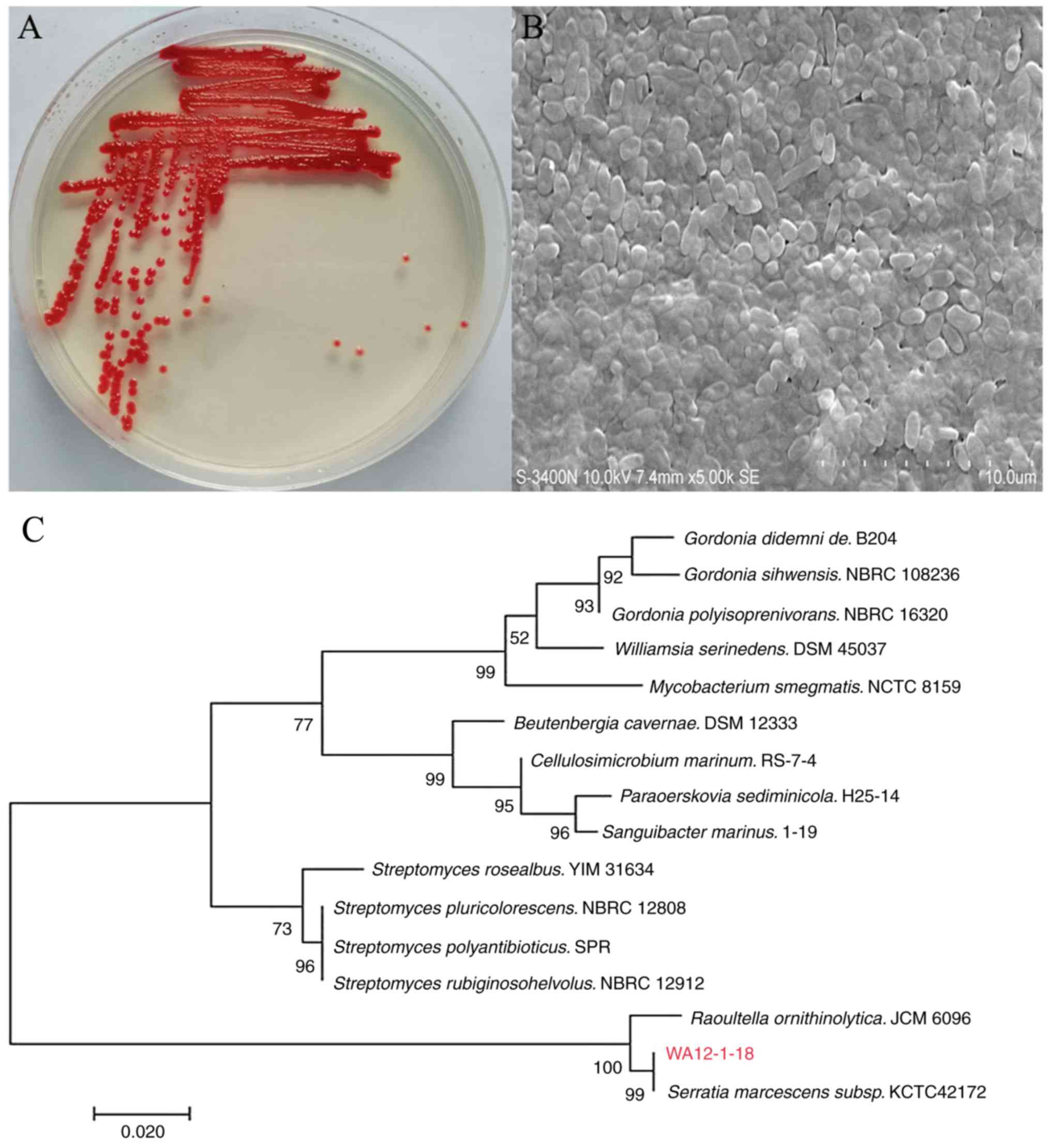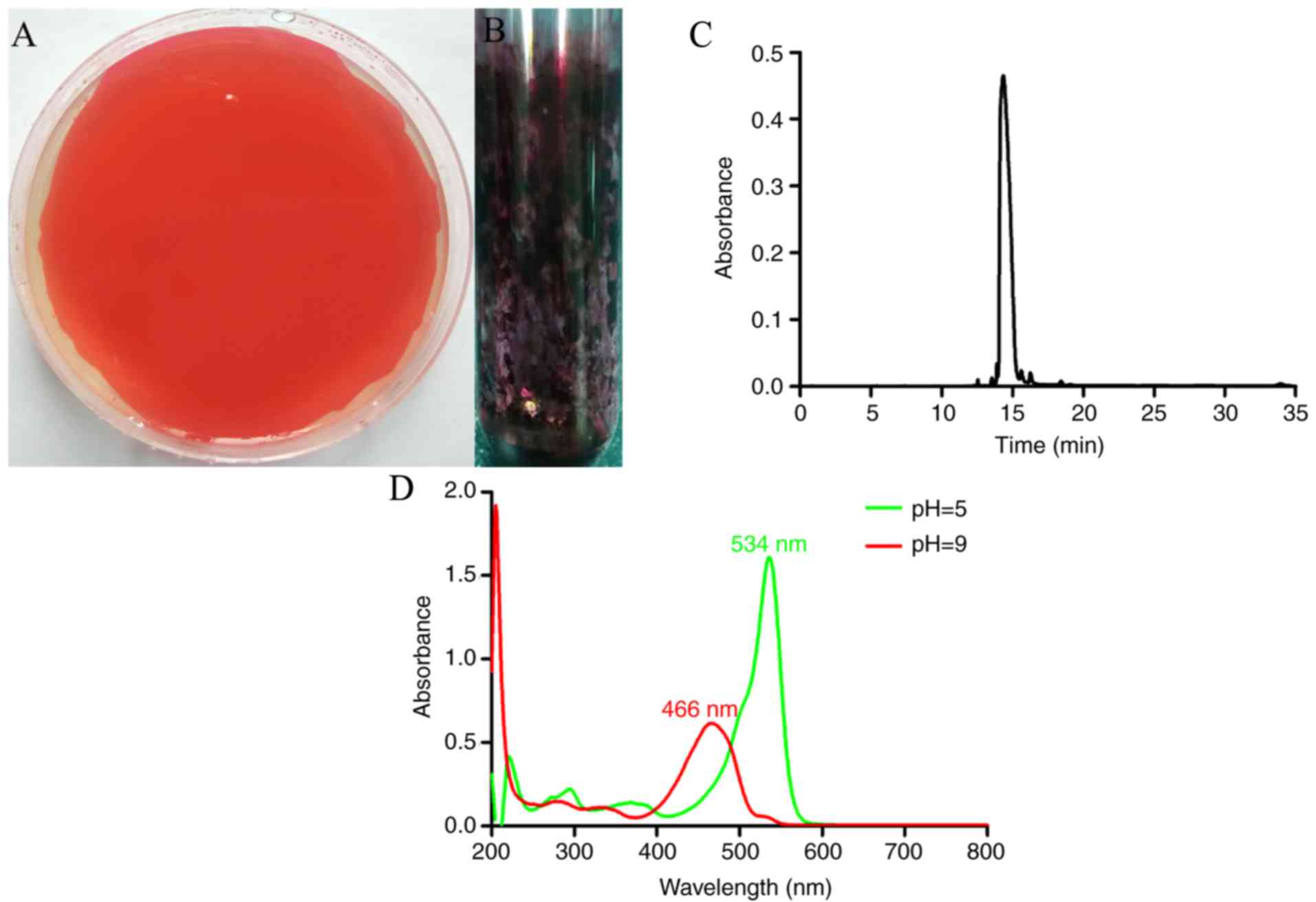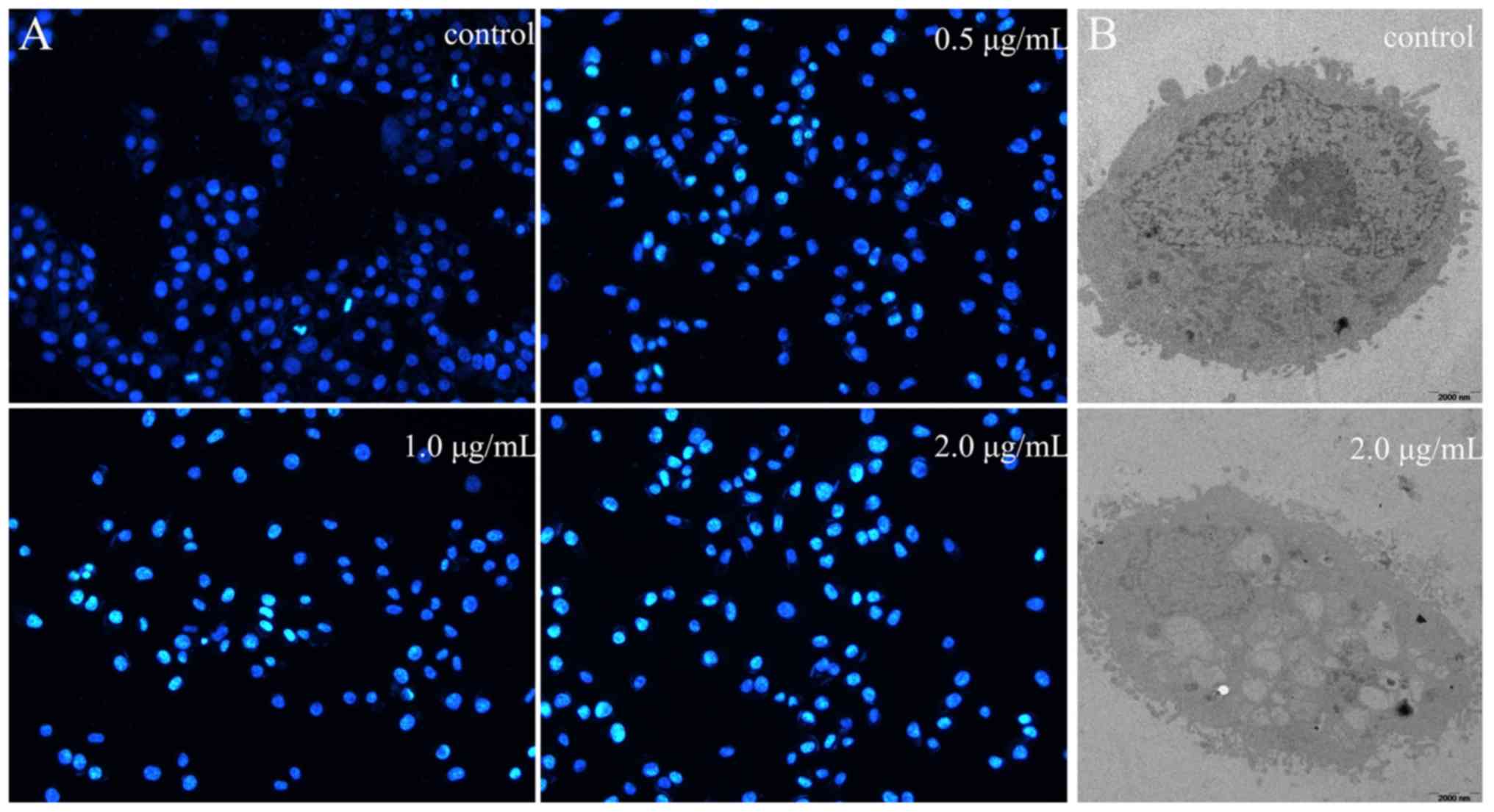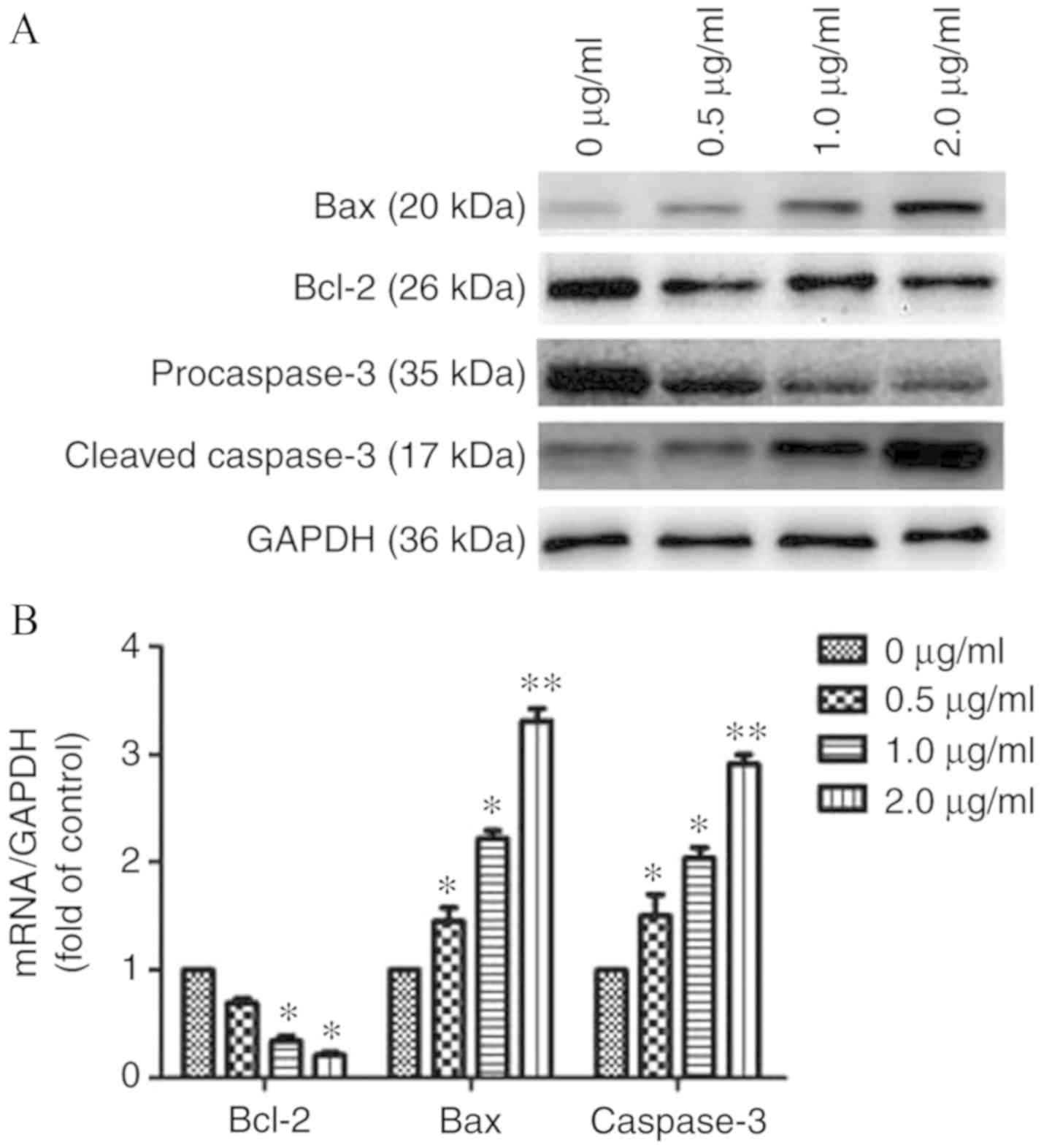|
1
|
Elkenawy NM, Yassin AS, Elhifnawy HN and
Amin MA: Optimization of prodigiosin production by Serratia
marcescens using crude glycerol and enhancing production using
gamma radiation. Biotechnol Rep. 14:47–53. 2017. View Article : Google Scholar
|
|
2
|
Zhang HC, Geng FN and Shen YM: The insect
gut microbiota plays crucial roles in modulating the interactions
between the host and intestinal pathogens. Chin J Ethnomed
Ethnopharmacy. 26:57–60. 2016.
|
|
3
|
Wang J: Effect of Periplaneta
americana extract on H125 lung cancer cells. Chin J Public
Health. 30:1400–1402. 2014.
|
|
4
|
Wang J and Xin L: Effects of
Periplaneta americana L. Extract on human hepatoma cells
Bel-7402. Chin J Modern Appl Pharm. 29:876–880. 2012.
|
|
5
|
Oh DC, Kauffman CA, Jensen PR and Fenical
W: Induced production of emericellamides A and B from the
marine-derived fungus emericella sp. in competing co-culture. J Nat
Prod. 70:515–520. 2007. View Article : Google Scholar : PubMed/NCBI
|
|
6
|
Rastogi S, Zhang D and Davis JT: The
natural product prodigiosin binds G-quadruplex DNA. Supramolecular
Chem. 28:1–12. 2016. View Article : Google Scholar
|
|
7
|
Xia Y, Wang G, Lin X, Song X and Ai L:
Solid-state fermentation with Serratia marcescens, Xd-1
enhanced production of prodigiosin by using bagasse as an inertia
matrix. Annal Microbiol. 66:1239–1247. 2016. View Article : Google Scholar
|
|
8
|
Nakashima T, Tamura T, Kurachi M,
Yamaguchi K and Oda T: Apoptosis mediated cytotoxicity of
prodigiosin-like red pigment produced by gamma proteobacterium and
its multiple bioactivities. Biol Pharm Bull. 28:2289–2295. 2005.
View Article : Google Scholar : PubMed/NCBI
|
|
9
|
Sumathi C, MohanaPriya D, Swarnalatha S,
Dinesh MG and Sekaran G: Production of prodigiosin using tannery
fleshing and evaluating its pharmacological effects.
ScientificWorldJournal. 2014:290–327. 2014. View Article : Google Scholar
|
|
10
|
Osei-Poku J, Mbogo CM, Palmer WJ and
Jiggins FM: Deep sequencing reveals extensive variation in the gut
microbiota of wild mosquitoes from Kenya. Mol Ecol. 21:5138–5150.
2012. View Article : Google Scholar : PubMed/NCBI
|
|
11
|
Suzuki N, Ohtaguro N, Yoshida Y, Hirai M,
Matsuo H, Yamada YL, Imamura N and Tsuchiya T: A compound inhibits
biofilm formation of staphylococcus aureus from streptomyces. Biol
Pharm Bull. 38:889–892. 2015. View Article : Google Scholar : PubMed/NCBI
|
|
12
|
Douglas AE: Multiorganismal insects:
Diversity and function of resident microorganisms. Annu Rev
Entomol. 60:17–34. 2015. View Article : Google Scholar : PubMed/NCBI
|
|
13
|
Someya N, Nakajima M, Hamamoto H,
Yamaguchi I and Akutsu K: Effects of light conditions on
prodigiosin stability in the biocontrol bacterium Serratia
marcescens, strain b2. J General Plant Pathol. 70:367–370.
2004. View Article : Google Scholar
|
|
14
|
Hassankhani R, Sam MR, Esmaeilou M and
Ahangar P: Prodigiosin isolated from cell wall of Serratia
marcescens alters expression of apoptosis-related genes and
increases apoptosis in colorectal cancer cells. Med Oncol.
32:3662015. View Article : Google Scholar : PubMed/NCBI
|
|
15
|
Miao L, Wang X, Jiang W, Yang S, Zhou H,
Zhai Y, Zhou X and Dong K: Optimization of the culture condition
for an antitumor bacterium serratia proteamacula 657 and
identification of the active compounds. World J Microbiol
Biotechnol. 29:855–863. 2013. View Article : Google Scholar : PubMed/NCBI
|
|
16
|
Patil CD, Patil SV, Salunke BK and
Salunkhe RB: Prodigiosin produced by Serratia marcescens
NMCC46 as a mosquito larvicidal agent against Aedes aegypti
and Anopheles stephensi. Parasitol Res. 109:1179–1187. 2011.
View Article : Google Scholar : PubMed/NCBI
|
|
17
|
Marsac P, Pierard N, Porot L, Wim Van den
bergh, Grenfell J, Mouillet V, Pouget S, Besamusca J, Farcas F,
Gabet T, et al: Potential and limits of FTIR methods for reclaimed
asphalt characterization. Materials Structures. 47:1273–1286. 2014.
View Article : Google Scholar
|
|
18
|
Pradeep S, Sarath Josh MK, Balachandran S,
Sudha Devi R, Sadasivam R, Thirugnanam PE, Doble M, Anderson RC and
Benjamin S: Achromobacter denitrificans, SP1 produces
pharmaceutically active 25C prodigiosin upon utilizing hazardous
di(2-ethylhexyl)phthalate. Bioresour Technol. 171:482–486. 2014.
View Article : Google Scholar : PubMed/NCBI
|
|
19
|
Danevčič T, Borić Vezjak M, Tabor M, Zorec
M and Stopar D: Prodigiosin induces autolysins in actively grown
bacillus subtilis cells. Front Microbiol. 7:272016. View Article : Google Scholar : PubMed/NCBI
|
|
20
|
Kimyon Ö, Das T, Ibugo AI, Kutty SK, Ho
KK, Tebben J, Kumar N and Manefield M: Serratia secondary
metabolite prodigiosin inhibits Pseudomonas aeruginosa
biofilm development by producing reactive oxygen species that
damage biological molecules. Front Microbiol. 7:9722016. View Article : Google Scholar : PubMed/NCBI
|
|
21
|
Darshan N and Manonmani HK: Prodigiosin
inhibits motility and activates bacterial cell death revealing
molecular biomarkers of programmed cell death. AMB Express.
6:502016. View Article : Google Scholar : PubMed/NCBI
|
|
22
|
Lee DJ, Lee JB, Jang HA, Ferrandon D and
Lee BL: An antimicrobial protein of the riptortus pedestris,
salivary gland was cleaved by a virulence factor of Serratia
marcescens. Dev Comp Immunol. 67:427–443. 2017. View Article : Google Scholar : PubMed/NCBI
|
|
23
|
Chen W, Liu Y, Zhang L, Gu X, Liu G,
Shahid M, Gao J, Ali T and Han B: Nocardia cyriacigeogica
from bovine mastitis induced in vitro apoptosis of bovine mammary
epithelial cells via activation of mitochondrial-caspase pathway.
Front Cell Infect Microbiol. 7:1942017. View Article : Google Scholar : PubMed/NCBI
|
|
24
|
Zhang J, Liu H, Sun Z, Xie J, Zhong G and
Yi X: Azadirachtin induced apoptosis in the prothoracic gland in
Bombyx mori and a pronounced Ca2+ release effect
in Sf9 cells. Int J Biol Sci. 13:1532–1539. 2017. View Article : Google Scholar : PubMed/NCBI
|
|
25
|
Zheng B, Zhou Y, Zhang H, Yang G, Hong Z,
Han D, Wang Q, He Z, Liu Y, Wu F, et al: Dl-3-n-butylphthalide
prevents the disruption of blood-spinal cord barrier via inhibiting
endoplasmic reticulum stress following spinal cord injury. Int J
Biol Sci. 13:1520–1532. 2017. View Article : Google Scholar : PubMed/NCBI
|
|
26
|
Livak KJ and Schmittgen TD: Analysis of
relative gene expression data using real-time quantitative PCR and
the 2−ΔΔCT method. Methods. 25:402–408. 2001. View Article : Google Scholar : PubMed/NCBI
|
|
27
|
Demain AL and Fang A: The natural
functions of secondary metabolites. Adv Biochem Eng Biotechnol.
69:1–39. 2000.PubMed/NCBI
|
|
28
|
Kan SC, Zang CZ, Yeh CW, Chang WF, Lin CC,
Hung TH, Shieh CJ and Liu YC: Enhanced bioconversion rate and
released substrate inhibition in (R)-phenylephrine
whole-cell bioconversion via partial acetone treatment. Enzyme
Microb Technol. 86:34–38. 2016. View Article : Google Scholar : PubMed/NCBI
|
|
29
|
Sruthy PB, Anjana JC, Rathinamala J and
Jayashree S: The role of red pigment prodigiosin from bacteria of
earthworm gut as an anticancer agent. J Microbiol Biotechnol Food
Sci. 4:246–251. 2015. View Article : Google Scholar
|
|
30
|
Lapenda JC, Silva PA, Vicalvi MC, Sena KX
and Nascimento SC: Antimicrobial activity of prodigiosin isolated
from Serratia marcescens UFPEDA 398. World J Microbiol
Biotechnol. 31:399–406. 2015. View Article : Google Scholar : PubMed/NCBI
|
|
31
|
Mienda BS, Idi A and Umar A:
Microbiological features of solid state fermentation and its
applications - An overview. Res Biotechnol. 2:21–26. 2011.
|
|
32
|
Kurbanoglu EB, Ozdal M, Ozdal OG and Algur
OF: Enhanced production of prodigiosin by Serratia
marcescens mo-1 using ram horn peptone. Braz J Microbial.
46:631–637. 2015. View Article : Google Scholar
|
|
33
|
Wei YH and Chen WC: Enhanced production of
prodigiosin-like pigment from Serratia marcescens, SMR by
medium improvement and oil-supplementation strategies. J Biosci
Bioeng. 99:616–622. 2005. View Article : Google Scholar : PubMed/NCBI
|
|
34
|
Suryavanshi MV, Waghmode SR, Bharti N,
Choudhari PB, Hingamire TB and Shouche YS: Isolation and virtual
screening of antimicrobial prodigiosin pigment from oxalotrophic
Serratia marcescens OX_R strain. J Appl Pharm Sci. 6:52–58.
2016. View Article : Google Scholar
|
|
35
|
Su JC, Chang JH, Huang JW, Chen PP, Chen
KF, Tseng PH and Shiau CW: Copper-obatoclax derivative complexes
mediate DNA cleavage and exhibit anti-cancer effects in
hepatocellular carcinoma. Chem Biol Interact. 228:108–113. 2015.
View Article : Google Scholar : PubMed/NCBI
|
|
36
|
Zhou W, Jin ZX and Wan YJ: Apoptosis of
human lung adenocarcinoma A549 cells induced by prodigiosin
analogue obtained from an entomopathogenic bacterium Serratia
marcescens. Appl Microbiol Biotechnol. 88:1269–1275. 2010.
View Article : Google Scholar : PubMed/NCBI
|
|
37
|
Pérez-Tomás R and Vinas M: New insights on
the antitumoral properties of prodiginines. Curr Med Chem.
17:2222–2231. 2010. View Article : Google Scholar : PubMed/NCBI
|
|
38
|
Montaner B, Navarro S, Piqué M, Vilaseca
M, Martinell M, Giralt E, Gil J and Pérez-Tomás R: Prodigiosin from
the supernatant of Serratia marcescens induces apoptosis in
haematopoietic cancer cell lines. Br J Pharmacol. 131:585–593.
2000. View Article : Google Scholar : PubMed/NCBI
|
|
39
|
Elahian F, Moghimi B, Dinmohammadi F,
Ghamghami M, Hamidi M and Mirzaei SA: The anticancer agent
prodigiosin is not a multidrug resistance protein substrate. DNA
Cell Biol. 32:90–97. 2013. View Article : Google Scholar : PubMed/NCBI
|


















